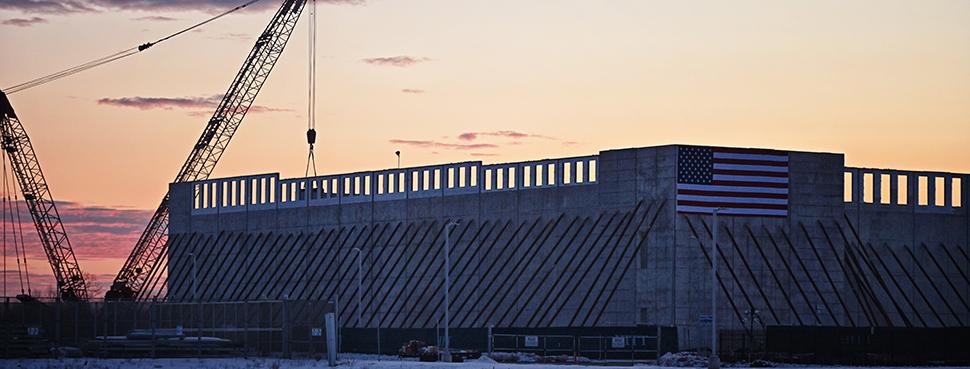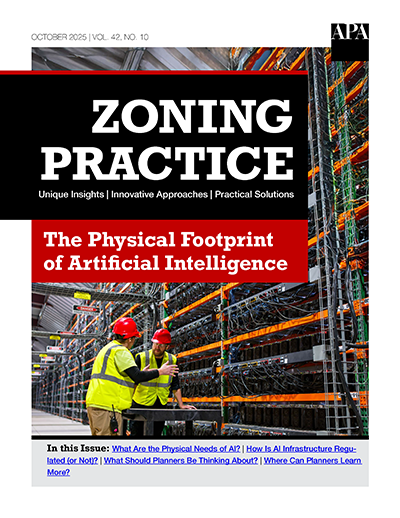Spotlight on Zoning Practice
Managing AI Build-Out in a Winner-Take-Most World

When I last wrote about data centers in June 2022, my focus was on cryptocurrency mining. Most of us had no idea that, just five months later, OpenAI would release ChatGPT and ignite a global race for artificial intelligence (AI) dominance. Even as generative AI tools have become commonplace in our work and personal lives, no company has cracked the code yet on a profitable business model, and now there is widespread speculation that this boom could go bust.
Here's a staggering figure from the Wall Street Journal: Leading technology companies have invested more in physical AI-related hardware and infrastructure over the past three years than the entire inflation-adjusted costs of the interstate highway system over its 40-year build-out. And the comparison to the highway system may not stop there. President Trump's Executive Order 14318, Accelerating Federal Permitting of Data Center Infrastructure, signals his administration's desire to throw the weight of the federal government behind the AI build-out.
As Charlie Nichols, AICP, notes in the October issue of Zoning Practice, "The Physical Footprint of Artificial Intelligence," AI may seem like something that happens on a screen, but it's "deeply physical" with clear stakes for local communities. The data centers that help train and serve AI models and the energy generation, storage, and transmission facilities necessary to power these data centers present a very tangible set of tradeoffs to host communities. And before this building boom is done, the total number of communities playing host to these facilities may rival the number of communities bisected by the interstate highway system.
Mixed Siting Authority and Federal Signals
As Nichols explains, most cities, towns, and counties have broad authority to control the siting and built form of data centers on private land through zoning. However, relatively few local zoning codes include explicit regulations for data centers (whether AI-related or otherwise).
And when it comes to the energy generation, storage, and transmission facilities necessary to run these data centers, siting authority is often more complicated. For example, nearly half of all states limit local siting authority, offer developers a way to bypass that authority, or maintain a parallel siting process for large-scale solar (and wind) projects.
This is the broader context for EO 14318, which streamlines federal environmental reviews and permitting processes for large AI-related data centers and associated power generation and transmission facilities. Importantly, the order only covers "dispatchable" (i.e., on-demand) power generation facilities and intentionally excludes wind and solar facilities, even when they are paired with battery energy storage systems. Beyond clearing the way for more AI-related data centers and energy infrastructure on federal lands, the order also directs federal agencies to steer financial resources toward AI-related projects (regardless of location).
While EO 14318 does not override local zoning, it may lead to electric grid capacity improvements that create demand for new data centers in parts of the country that wouldn't otherwise be desirable for AI companies. It may also fuel significant new investments in natural gas or even coal power plants, even though solar and wind facilities are currently the cheapest and fastest power sources to get online. These investments may be supercharged by separate Trump administration and Congressional actions that canceled the federal investment tax credit for wind and solar projects, paused new wind and solar approvals on federal lands, and revoked some federal approvals for wind and solar facilities.
Consequently, EO 14318 may make it harder for AI companies to meet their clean power goals and, despite its name, even slow down the AI build-out. Furthermore, the aggregate effects of the order could deepen and widen already existing cracks that threaten the "social license" of data centers.
An Evolving Social License
The AI build-out has global implications but highly localized land use impacts. Nichols details the mind-boggling spatial, energy, and water needs of AI-related data centers and their potential to vastly increase carbon emissions.
Now, all land uses have effects on nearby properties and host communities. However, perceptions about the acceptability of different land use impacts are directly related to whether community members recognize the social utility of the land use in question and trust the operator to act in good faith (i.e., the social license of the use). While the social license of a given use is not, technically, related to whether it is legally permissible or not, it obviously affects the decisions that local officials make about zoning standards and discretionary land use applications.
Back in June 2022, I noted that, perhaps, the most important difference between cryptocurrency mining facilities and data centers was that data centers already had a social license to operate, while cryptocurrency mining was still of uncertain social utility. I reasoned that people generally understood and appreciated the importance of data centers to the functioning of the internet. But now it's clear that the rapid proliferation and dispersal of AI-related data centers is causing a reevaluation of that social license. Opposition to data center projects is becoming more common, and there seems to be a growing chorus of researchers and advocates sounding the alarm about the imbalance of costs and benefits to host communities.
A Reasonable Zoning Response
According to Nichols, a sound approach to regulating AI-related data centers starts with proactive community and regional planning. Without a clear assessment of local data center (and associated infrastructure) demand and the likely interrelated effects of these facilities on a community, planners and local officials are stuck reacting to project proposals rather than thoughtfully managing community change. However, the key features of a reasonable zoning response to the AI buildout are clear.
Treat Data Centers as a Distinct Use
Defining and regulating data centers as a distinct use is the cornerstone of a targeted zoning strategy. This allows the local jurisdiction to designate permissible or potentially permissible locations for new data center projects and to differentiate between otherwise similar projects based on floor or project site area, energy or water demand, or other land use characteristics.
As Nichols points out, several cities and counties have recently adopted or updated zoning definitions and standards for data centers. For example, Fairfax County, Virginia, defines a data center as "a facility containing one or more large-scale computer systems used for data storage and processing for off-site users. Typical supporting equipment includes back-up batteries and power generators, cooling units, fire suppression systems, and enhanced security features" (§9103). The county's zoning standards permit data centers in most commercial and industrial districts but specify that applicants must secure a discretionary use permit if the proposed floor area exceeds 40,000 square feet in commercial districts and 80,000 square feet in industrial districts (§4102.6.A).
Mitigate Noise
Data centers typically use massive air conditioning units and often use liquid cooling systems to keep equipment operating efficiently. As Nichols notes, this cooling infrastructure often generates almost continuous low-frequency noise as roof- or ground-mounted compressors run and water pumps cycle on and off. Without sound mitigation, data centers can be highly annoying (and even a health risk) to occupants of nearby residences.
Consequently, many recently adopted zoning regulations for data centers include one or more requirements aimed at limiting residential exposure to harmful noise levels. For example, Fairfax County prohibits new data centers within 200 feet of residential districts and uses, stipulates that ground-mounted cooling or backup power equipment must be further removed from those districts and uses, and requires all data center applicants to submit a noise study demonstrating how the facility will comply with the county's noise ordinance (§4102.6.A).
Consider Utility Impacts
Nichols stresses that cumulative power and water demand from multiple data centers can quickly overwhelm local utilities. While zoning is not typically the most effective tool for managing the effects of the AI build-out on utility customers, it can play a supporting role. For example, Atlanta recently adopted a data center ordinance that requires discretionary use permit applicants to submit "water conservation and sustainability" and "energy consumption" plans (Ordinance 25-O-1063).
Protect Against "Ghost Boxes"
Industry leaders are now openly speculating that we're in an AI bubble and that, once that bubble bursts, there will be a small number of big winners. If this is true, then we may be racing toward a short-term oversupply of data centers. That is, once the AI sector consolidates around a small number of profitable companies, the landscape may be littered with "ghost boxes" (i.e., idled data centers) once owned or operated on behalf of their former competitors.
While I'm not aware of any cities, towns, or counties that have addressed this potential outcome in their zoning regulations, it may be analogous to the oversupply of big-box retail. Both uses typically rely on purpose-built utilitarian and boxy structures that are seldom easily adaptable or highly desirable for other uses. Furthermore, a strategy some communities have used to mitigate the effects of vacant big box structures may also work for AI-related data centers.
In response to concerns about big box blight, some communities require applicants to post a security bond to cover the costs of demolition and safeguard against "white elephant" structures (see PAS Report 537). For example, Ferndale, Washington, requires developers to either submit adaptive reuse plans for single-purpose structures of over 50,000 square feet or to post a bond equal to 150 percent of estimated demolition costs (§18.58.060.L). A similar approach may be appropriate for new hyperscale data centers.
Subscribe to Zoning Practice

Each issue of Zoning Practice provides practical guidance for planners and land use attorneys engaged in drafting or administering local land use and development regulations. An annual subscription to ZP includes access to the complete archive of previous issues.
Top image: Gerville / iStock / Getty Images Plus


